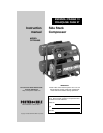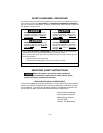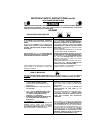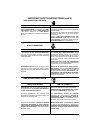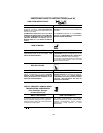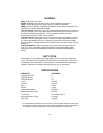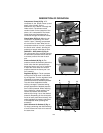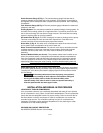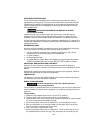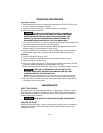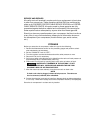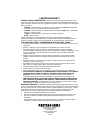
10-ENG
OPERATING PROCEDURES
Preparation for Use:
1. Before attaching air hose or accessories, make sure the OFF/AUTO lever is set
to “OFF” and the air regulator is closed.
2. Inspect air intake filter (H) Fig. 1. Clean or replace as necessary.
3. Attach hose and accessories.
TOO MUCH AIR PRESSURE CAUSES A HAZARDOUS
RISK OF BURSTING. CHECK THE MANUFACTURER’S MAXIMUM
PRESSURE RATING FOR AIR TOOLS AND ACCESSORIES. THE
REGULATOR OUTLET PRESSURE MUST NEVER EXCEED THE
MAXIMUM PRESSURE RATING OF THE TOOL BEING USED.
4. Turn the OFF/AUTO lever to “AUTO” and allow tank pressure to build. Motor will
stop when tank pressure reaches “cut-out” pressure.
5. Open the regulator by turning it clockwise. Adjust the regulator to the correct
pressure setting. The compressor is ready for use.
6. Always operate the air compressor in well ventilated areas, free of gasoline or
other solvent vapors. Do not operate the compressor near the spray area.
After Use:
7. Set the “OFF/AUTO” lever to “OFF”.
8. Turn the regulator counterclockwise to set the outlet pressure to zero.
9. Remove the air tool or accessory.
10.Pull ring on safety valve (K) Fig. 3, allowing air to bleed from the tank until tank
pressure is approximately 20 psi. Release safety valve ring.
11.Drain water from air tank. Turn drain valve (J) Fig. 2, counterclockwise, to open.
WATER WILL CONDENSE IN THE AIR TANK. IF NOT
DRAINED, WATER WILL CORRODE AND WEAKEN THE AIR TANK
CAUSING A RISK OF AIR TANK RUPTURE.
NOTE: If drain valve is plugged, pull ring on safety valve (K) Fig. 3, and hold until all air
pressure has been released. The valve can then be removed, cleaned, and reinstalled.
12.After the water has been completely drained, turn drain valve to close. The air
compressor can now be stored.
MAINTENANCE
KEEP TOOL CLEAN
Periodically blow out all air passages with dry compressed air. Inspect air intake
filter and clean or replace as necessary. Clean all plastic parts with a soft damp
cloth. NEVER use solvents to clean plastic parts. They could possibly dissolve or
otherwise damage the material.
WEAR SAFETY GLASSES WHILE USING COMPRESSED
AIR.
FAILURE TO START
Should your tool fail to start, check to make sure the prongs on the cord plug are
making good contact in the outlet. Also, check for blown fuses or open circuit
breakers in the line.



